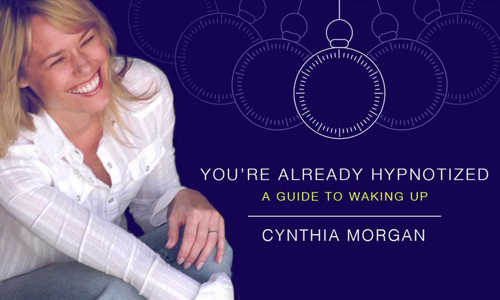
Why You’re Already Hypnotized: A Guide to Waking Up?
In the summer of 1996, I began to write a book on A Course in Miracles. I had been a student and teacher for a number of years at that point and wanted to share my understanding of the Course with others. I worked on that book for years, but it never quite felt right, so I ended up shelving it. While writing it, however, I was reading a lot of Freud in order to better my understanding of ACIM, and I kept running across his mention of hypnosis. I became more and more intrigued by hypnosis, and in 2002 I moved to Santa Fe, NM to study hypnosis and become a hypnotherapist. The move was ignited by a curiosity about hypnosis, of which I knew absolutely nothing, and a desire to learn more about the unconscious mind, and the ego dynamics that the Course talks about.
After three years of practice as a hypnotherapist, I decided to write a second book solely on hypnotherapy. The inspiration for that book came from my clients. I had moved from Kansas to Los Angeles, and I wanted my clients in Kansas (or anywhere for that matter) that didn’t have access to a hypnotherapist or to a class on A Course in Miracles to be able to have information about either, and a means to understand and heal their mind. But as I wrote the book, ACIM principles kept creeping into my writing. I spent a solid year deleting Course ideas and then adding them back in. What I learned during that frustrating time was that I could not write a book without mentioning ACIM, since it is the lens in which I see the world. Once I decided to leave the Course material in the book, I went back to the first book (on ACIM) and added that information into the second book (on hypnosis), which really became a third book, You’re Already Hypnotized (on both ACIM and hypnosis). Almost all of the Course references in the book are from my first book, written 15 years earlier. Somehow it began to make sense to meld the two. I realized that hypnosis and ACIM really had a similar goal: peace. And the same means to achieve that goal: replacing old thoughts with new thoughts.
The title of the book came from what I say to new clients during their first session. Often they’re apprehensive about being hypnotized by me, so I explain that they are already hypnotized or “programmed” by false ideas. By that I mean their mind is filled with negative, unhelpful, and untrue thoughts. I’m just helping them to release the beliefs that are standing in the way of their true self. When I say to them, “I am really a de-hypnotherapist, because you’re already hypnotized” people seem to relax and get it. It’s sort of an a-ha moment for them.
How is it possible that we can be hypnotized and not know it?
A definition of hypnosis could be: believing something is real even when it’s not. Our minds are filled with ideas, beliefs and thoughts that we think are real, but in reality are not. Thoughts like: “I am unlovable. I am unworthy. I will always be fat. Sex is scary. The world is unsafe.” We walk around with these thoughts on repeat in our subconscious mind, and we respond to life robotically based on these thoughts. Our ego, authority figures, our past, and our culture, all contribute to “programming” our minds with false ideas. ACIM tells us, “Beliefs are real to the believer.” These beliefs are not necessarily the Truth—it’s not true that you are unlovable or unworthy or that you will always be fat—but we believe they are true. And then they become our truth. And that truth determines our experience. We can see the obvious example in terrorists or extremists or Nazi Germany: they believe they are doing the right thing by murdering certain others, but clearly they’ve been “programmed” into this wrong-minded thinking. You could not tell them they were hypnotized though, because they wouldn’t believe you.
Can we stop ourselves from being hypnotized during every day life?
Not before the ages of 9 through 11. Before that we are an open subconscious mind, fully ripe for programming. That’s why you can tell a child about the Tooth Fairy and he or she will believe you. Nothing is getting filtered because children have not yet developed the critical factor, which acts like a gatekeeper between the conscious and the subconscious mind. The critical factor filters the information from the conscious mind into the subconscious mind. At some point, the child will no longer believe in a tooth fairy because it won’t make sense to their conscious mind. But just because we’ve developed a critical factor does not mean we don’t still get programmed. We do—mostly by authority figures such as parents, coaches, doctors, therapists, politicians, and the news—those we consider experts.
The best way to stop yourself from being hypnotized is to question everything. Do your own research and ask for guidance from your higher self. Really it’s about waking up. To wake up is to heal. It takes great practice and discipline, and it requires diligence and quiet time, such as meditation, to distinguish between as the Course says, “real” and “unreal” thoughts. We are all hypnotized on some level, but some are more awake than others. Daily spiritual practice and self-hypnosis shield you from potential ego thinking and being hypnotized by the world through reconnecting you back to your truth. When we forget who we are, we are easily hypnotizable by others and society.
When I say to them, “I am really a de-hypnotherapist, because you’re already hypnotized” people seem to relax and get it. It’s sort of an a-ha moment for them.
What are some great steps someone could put into action on a daily basis?
A good place to start de-hypnotizing is by recognizing that there is unlimited potential within—that you are a powerful, creative spiritual being, and you are not defined by your past, your present, your bank account, your age, nor are you a victim—unless you choose to be. You are the creator of your experience. As mentioned, daily meditation, self-hypnosis exercises and affirmations are useful actions to facilitate healing, which is why I included all of them in the workbook section of the book.
At what point did you realize we’re already hypnotized?
It came during my training as a hypnotherapist. Most hypnotherapists, I would think, understand the idea that our job is really that of de-hypnotizing. It wasn’t until I was exposed to hypnotherapy that I truly understood it in those terms. One of my instructors said something to the effect in a class, and it hit me like a lightening bolt that we are all already hypnotized.
What can readers learn from experiencing your book?
In school, we are taught in detail about how our body works, but no one teaches us how our mind works, unless you study psychology in college. And even that is limited. So my first hope is that readers walk away with a better understanding of their mind. And through that knowledge, I hope they learn just how much control they can have over their mind and thus their emotions, their experience, and their future. Lastly, I hope they are inspired to begin doing the exercises in the book to start their journey of waking up.
For those who haven’t heard of A Course in Miracles, can you speak about your experience of it? (how has affected/changed/inspired your life)
I consider myself a seeker. I began Transcendental Meditation at seven years old, and spent my life reading spiritual or new age books and attending lectures and workshops of some of our greatest leaders in the field. But there was always something missing in everything I sought. Nothing and no one could, to my satisfaction, answer all the questions I had—until I found A Course in Miracles. It all just sort of clicked into place. It was what I was seeking. And I was 19 at the time. A Course in Miracles has informed my life. It has shaped my thinking. As mentioned, it’s the lens in which I see the world. It is what guided me to becoming a hypnotherapist, to meeting my husband, who was also a student of A Course in Miracles when I met him, and it inspires my work as an animal activist, as well. As cheesy as it sounds, ACIM is the air in which I breathe. I understand my life better, I understand the motivation of myself and others, I understand why we are all here, what we are trying to achieve. With that understanding I have become more at peace and fulfilled.
What were your main influences, which may have inspired the book, and throughout writing it?
My main influence was the work of Dr. Kenneth Wapnick, the foremost scholar of A Course in Miracles. Kenneth passed away a few weeks ago, but I considered him my spiritual teacher. I feel very fortunate to have known him. His work is present throughout the book.
You have incredibly powerful digital hypnotherapy sessions available for download. How can these help people?
The hypnotherapy session downloads are the experience of the shifts or change I write about through the book. We can talk until we’re blue in the face about wanting to change, or how to change, or self-development or enlightenment, but it’s not until we actually do something different that we do change. The downloads are versions of hypnotherapy sessions that I perform in my office. Again, they were created for people who could not work with me for whatever reason—price or location. I sell them for just $1.99 each so that anyone anywhere can begin healing today. Now there’s no excuse!
Most hypnotherapy sessions available on the market are suggestion therapy sessions. Meaning, the therapist makes suggestions like, “You no longer like to smoke,” or whatever, into the listener’s mind. These can be very helpful sessions, but I find that what most people need is to dig in and release what is holding them back. Then the suggestion therapy will sink in more unobstructed. Without really looking at what you are holding onto, suggestion therapy is just a band-aid over a gaping wound. It might stop the bleeding temporarily, but at some point, you have to address the wound. My sessions are interactive, meaning I guide you into your subconscious mind where you can look at your own thoughts and beliefs or memories that are blocking you, and undo those.
The sessions in the book are the same ones I’ve recorded, so you can either record them in your voice from the book or have me guide you through them.
How do the downloads and book work together?
The book is broken up into three parts. Part 1 details the different parts of your mind—the conscious, subconscious and superconscious—and it also explains hypnosis and the metaphysics and foundational message and teachings of A Course in Miracles. Part 2 takes those two thought systems—hypnosis and ACIM—and applies their principles to 12 chapters, each addressing a different everyday topic, like relationships, money, career, and bad habits. Part 3 is the workbook section where I teach readers self-hypnosis, give them 30 daily reprogramming statements for each topic, and provide a worksheet to begin looking at their own negative thoughts and change them, and a few self-hypnosis exercises per chapter to do, as well. I originally conceived the book as a one-year program, which is why there are 12 chapters, one for each month, and 30 daily reprogramming statements, one for each day of the month. But you can use the book however you like. It doesn’t matter.
When someone becomes de-hypnotized, what changes could they expect in their life?
They can expect to become lighter, happier, healthier, more abundant, create their ideal body, release bad habits, meet their soul mate, become more engaged in helping the world, have a desire to be of service, wake up in the morning with a deep sense of purpose, find true empathy and connection to everyone and everything, and be surrounded by an ever present peace that goes with them wherever they go. Just to name a few.
Purchase You’re Already Hypnotized: A Guide to Waking Up HERE. Download Cynthia Morgan’s recorded hypnotherapy sessions HERE.
This interview is not copyright protected, and may be shared and republished in its entirety only (no editing permitted). Please email us with any questions.
Watch Cynthia talk about her new book here:


